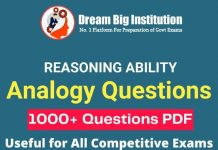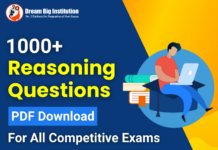Hello Dear Aspirants,
Data Sufficiency Questions and Answers PDF Free Download
Are you looking for any of the below queries?
- Data Sufficiency
- Data Sufficiency Reasoning
- Data Sufficiency Reasoning Questions
- Data Sufficiency Tricks
- Data Sufficiency Questions and Answers PDF
- Data Sufficiency Reasoning Problems
- Data Sufficiency PDF
- Data Sufficiency Questions for Bank Po
If you are looking for any of the above, then your search has ended.
Table of Contents
Data Sufficiency Questions and Answers PDF Free Download
Data Sufficiency Questions and Answers PDF Free Download: Data sufficiency in Reasoning covers many different topics in the reasoning section. In this topic, a question is followed by two or three statements, and a student needs to determine whether a question can be solved by any of the statements, using a combination of statements or no statement can be used to solve the question.
You just need to check whether the data which has been provided is sufficient to help you solve the required question. Since a variety of questions can be framed from this topic, one needs to be an active reader and go through every statement carefully.
A number of competitive exams feature questions related to the topic and can range from anywhere between 3-to 5 questions in the reasoning section.
Exams, where these types of questions are asked, include IBPS PO, IBPS SO, IBPS Clerk, SBI Clerk, SBI PO, IBPS RRB, RBI Grade B, RBI Assistant, LIC, SSC, Railway, GMAT, CAT, and Infosys exams.
In competitive exams, you are likely to find tricky questions based on this topic as the concept of averages is quite easy and known to all.
What Is Data Sufficiency?
Data Sufficiency is to check and test the given set of information, whether it is enough to answer a question or not. Data Sufficiency-type questions are designed to test the candidate’s ability to relate given information to reach conclusion. Moreover, that Data sufficiency has wider attributes to test the student. On one hand, it may have problems with any of the topics of reasoning or Quantitative Aptitude and on the other hand, it can test a candidate’s analytical skills.
Generally, a question on any of the topics such as sequence, Ranking, Puzzle test, coding-decoding, blood relation, and so on is followed by two-three, or any number of statements. These statements may contain information to arrive at the answer. Students need to decide which of the statement(s) is/are sufficient to answer the given questions.
Data Sufficiency Questions and Answers PDF Free Download (Highlight)
| Description | Details |
| Article Name | Data Sufficiency Questions and Answers PDF |
| Category | Study Material |
| Covers | Data Sufficiency Questions and Answers |
| Total Questions | 150+ |
| Useful For | IBPS PO, IBPS Clerk, SBI PO, SBI Clerk, Bank PO, Insurance, SSC, Railway, GMAT, CAT, Infosys Exam |
| Language | English |
| Format | |
| Quality | Best |
| Compiled By | Dream Big Institution |
Data Sufficiency Questions and Answers PDF Free Download
Data Sufficiency is a part of the reasoning ability and quantitative aptitude section. It is the common topic of all government and bank exams. data sufficiency questions are respected with maths and logical reasoning. In competitive exams, you are likely to find tricky questions based on this topic as the concept of averages is quite easy and known to all.
Data Sufficiency Questions and Answers PDF for Bank PO
Bank PO data sufficiency questions and answers, made by professional experts at Dream Big Institution, aim to provide the Bank PO aspirants with the best data sufficiency preparation material and with the best learning methodology. These practice questions will help you in preparing for the data sufficiency topic in a well-planned way. If you attempt the practice set with dedication, it will improve your data sufficiency question-solving speed, and also your accuracy. The practice set has questions about a variety of difficulty levels. The Bank PO data sufficiency solutions can be used to verify your answers. Further features of the data sufficiency practice questions are –
- It consists of a total of 30 data sufficiency questions.
- Solving data sufficiency questions randomly is allowed
- Option for switching to the other data sufficiency question will be given
- The progress study report will help to keep track of your Bank PO exam preparation
- All the Bank PO data sufficiency questions are highly selected and of different formats that can come in the exam.
- It also helps you to cover your complete data sufficiency topic with ease.
Data Sufficiency Questions And Answers For Bank PO
Direction:(1-5): In each of the following questions, a question & then two statements – I & II are given. You have to determine whether the data provided in these statements is enough to answer the question or not. Study both the statement:
Give the Answer (A) If the data are given only in statement I is enough to answer the question.
Give the Answer (B) If the data given only in statement II is enough to answer the question.
Give the Answer (C) If the data given in either statement I or in statement II is enough to answer the question.
Give the Answer (D) If the data given in both the statements- I & II is not enough.
Give the Answer (E) If the data given in statements- I & II – both are required.
Q.1. How many students are in the class?
I. Nisha’s rank in the class from the top is 10th & from the bottom is 23rd.
II. Nandita is 10 rank above Roopa, who is 18th from the top.
Ans. A
Q.2. Who is the tallest among P, T, J, L, & F having different heights?
I. P is taller than only J & F.
II. T is not the tallest one.
Ans. D
Q.3. In which direction is village ‘P’ with respect to village ‘Q’?
I. Village H is in the East of P & in the South of Q.
II. Village F is in the North of P & in the west of Q.
Ans. E
Q.4. How many sons does ‘X’ have?
I. D is a brother of A, who is a son of X.
II. D’s sister is M’s wife.
Ans. A
Q.5. What is the code of Tail in the code language?
I. ‘Delay’ is written as 57382 in the code language.
II. TIDE is written as 6457 in the code language.
Ans. E
Direction:(6-10): In each of the following questions, a question & two statements – I & II are given. You have to determine that the data provided in these statements is enough to answer the question or not. Study both the statement:
Give the Answer (A) If the data given only statement I is enough to answer the question.
Give the Answer (B) If the data given only statement II is enough to answer the question.
Give the Answer (C) If the data given in either statement I or in statement II is enough to answer the question.
Give the Answer (D) If the data given in both the statements- I & II is not enough.
Give the Answer (E) If the data given in statements- I & II – both are required.
Q.6. What is Nitesh’s rank in the class?
I. Madhur is two ranks ahead of Nitesh, who is in the first 15% of the class.
2. Samir is six ranks below Nitesh & 25th form the bottom.
Ans. D
Q.7. Which is the day of the week of Sudha’s birthdate?
I. The day on her birthdate is at least after two days from Wednesday.
II. She celebrated her birthday in 2006 after five days from the Independence Day of India.
Ans. B
Q.8. What is the relation of X with Y?
I. X is the only son of Y’s mother-in-law.
II. The only daughter of X has only brother, who is Y’s son.
Ans. A
Q.9. In which direction is Rahul facing?
I. He turned to the left for twice respectively from to the starting point P.
II. He started to walk in the North from point P.
Ans. E
Q.10. Who among P, Q, R & T is the heaviest?
I. Q is lighter than T only, While P is lighter than R.
II. T is weight is 20 times of R’s weight, while 35 times of R’s weight.
Ans. A
CAT Data Sufficiency Questions and Answers PDF
Nowadays, everything revolves around data, all major decisions are made by first collecting the mass information and then analyzing the raw data. Whether it may be a small firm, a giant MNC or a governments all rely on the inferences made on this massive data. Thus, we cannot undermine the resourcefulness and significance of data. But mere collecting data is not sufficient. You have to consider that while collecting the data all the relevant information required to make inferences is covered otherwise the whole exercise of collecting and interpreting the data proves to be a futile activity.
That’s what Data Sufficiency questions are in the competitive exam. Data Sufficiency is part of the reasoning section in various competitive exams such as Bank PO’s, CAT, and other leading MBA entrance exams. Data sufficiency problems don’t involve difficult concepts or formulas, it just tests your reasoning and analytical skills combined with basic mathematics. In Data Sufficiency problems you have to decide whether the given data is sufficient to answer the questions or not. The format of the question in the exam is as follows:
CAT Data Sufficiency Questions and Answers PDF
There would be two statements given in questions labeled (1) and (2) and you have to decide if these statements are sufficient to conclusively answer the question. The following questions are
- If statement (1) alone is sufficient to answer the question but statement (2) alone is not sufficient to answer the question.
- If statement (2) alone is sufficient to answer the question but statement (1) alone is not sufficient to answer the question.
- If you can get the answer from (1) and (2) together although neither statement by itself
- If statement (1) alone is sufficient and statement (2) alone is sufficient.
- If you cannot get the answer from statements (1) and (2) together but still more data are needed.
The questions can be categorized into the following types
- Relationships
- Dates
- Comparison
- Critical Analysis
- Age
- Miscellaneous
- Relationship
The conventional questions are of the following type. Consider,
Example 1: How is A related to B?
- B is the father of A.
- D is the brother of A.
Now before hopping to the conclusion, I’ll point out a mistake that students tend to make in such questions is that they conclude about the relationship without knowing the sex of the person involved.
Now let’s check out the statement (1) that says that B is the father of A. Is it enough to conclude how A is related to B? Now A can either be B’s son or daughter. So, to establish a relationship of A to B we need to learn whether A is male or female or indirect terms:
- A is the brother/sister of X.
- A is the father/mother of X.
- A is an uncle/aunt of X.
Now using the suggested method above we can notice that statement (1) is not sufficient to answer the question. Similarly, statement (2) cannot bring us to any conclusion about the relationship between A and B. Thus, the answer is we cannot get the answer from statements (1) and (2) together but still more data are needed.
- Dates
In this category, the questions asked are
- On which day of the week did X reach z city?
- What is the date of birth of X?
Note that a day or date can only be known if,
- The ‘day’ or ‘date’ of some earlier incident is mentioned,
- The number of days between that incident and the required day is given.
Consider this example now,
Example 2: “On which day of the week did Rahul reached Delhi?”
Statement (1) Rahul’s brother reached Delhi a day before than Rahul.
Statement (2) Rahul’s father reached Delhi on Thursday which was two days later than the arrival of his brother.
Sol: As you can notice that Statement (1) provides us the information on the no. of days between an earlier incident and the required day. Now we need to know the day when Rahul’s brother reached Delhi. And for this, we turn to statement (2), thus, we know the answer can’t be A or D as the statement (1) is not sufficient to answer the question alone. Now, statement (2) says Rahul’s mother reached Delhi on Thursday i.e. two days later than his brother thus Rahul’s brother reached Delhi on Tuesday therefore from both statements we can infer that Rahul reached Delhi on Wednesday. Hence, C is the correct answer i.e. both statements are required altogether to make a conclusion.
- Comparison
As the name recommends, the questions require comparison and then put up questions such as “Who’s the tallest or heaviest among X, Y, and Z?” or “Who’s sitting on the left of A when A, B, and C are sitting together?” In all these questions you need to write the names of people in ascending or descending order of heights, weights, or their sitting arrangement from left to right.
To solve such a question the best method to employ is the use of inequalities to write the statements and then see if the two can be combined to form into single inequality to get the answer. Let’s do an example to understand how it’s done.
Example 3: Among four friends K, L, M, and N, who’s the heaviest?
Statement (1) L is heavier than K but lighter than N.
Statement (2) M is lighter than L
Sol: To find out the answer to the above question we will form an inequality and using the information given in the statement (1) we get,
K < L < N
And, using the second statement we get,
M < L
Combining the inequalities, we get,
K < M < L < N, or M < K < L <N
Thus, in either of the two N is the heaviest. Hence, the answer is C as we needed both the two statements to derive the answer to the question.
- Critical Analysis
This category includes questions that are qualitative in nature, that involve the application of value-judgment in order to reach a conclusion. To tackle these types of problems you need to revise your general background of argumentation techniques, an assumption of arguments, and inference making. There’s no general and direct method to solve such problems, but they aren’t very difficult to approach. Let’s try an example that will give you a rough idea of the thinking and approach required to cope with them.
Example 4: Many Indian experts think that India has a very meager oil reserve. Is that correct?
Statement (1): India imports about 1.5 crore tons of crude oil every year.
Statement (2): When foreign countries were recently invited to participate in exploration and production activity in India, nearly 67 companies took up the offer.
Sol: First let’s ponder and deduce about the statement (1). Note that statement (1) does not imply that importing tons of crude oil mean India has low oil reserve. High Imports can be due to the huge consumption or small production. And when we move on to the statement (2), It also doesn’t directly suggest that 67 companies did not take up the offer because of the low reserves. They might be willing to do so because of favorable of socio, political and economic incentives. Hence, both the statements neither individually or jointly derive us to an accurate conclusion. Thus, the answer is E.
- Age
Again, as the name suggests, this kind has two statements and then a question that demands you to find out the age of the person. Note that the real question is not to actually find the age but to tell whether the statements are sufficient to calculate the age of the desired person. Usually, one information or one statement provides one equation i.e. one information = one equation.
And, one person’s name implies one unknown i.e. one person = One unknown
The approach you need to follow in these questions is that if no. of equations is equal to the no. of unknowns then the data is sufficient otherwise not.
Example 5: Is my son 12 years old?
Statement (1): Four years later, he will be 20 years younger than me
Statement (2): Now I am 20 years older than him.
Sol: This is a deceptive problem. Observe that there are two unknowns here Father and son and what about the no. of equations? The information is only about one i.e. the father. Both the statements tell about the father only, though the language is bit tricky and thus, there’s 1 info and two unknowns. Hence, the answer is E.
How to Solve Question-Based on Data Sufficiency – Know all Tips and Tricks
Aspirants can find various tips and tricks below for solving the questions related to the Data Sufficiency reasoning section.
Tip 1: In Data Sufficiency, students only need to check whether the data provided is sufficient or not to find the answer. Therefore, do not waste time in finding the final answer.
Tip 2: Data Sufficiency problems appear to be difficult at first because of the complicated directions, but once you get familiar with these directions, you will find these problems easy to solve. Never assume anything by yourself.
Tip 3: Always read the question carefully and identify the specific information required to answer the question. Read the statements carefully and understand them and then finally analyze the statements and try to eliminate some answer choices. This will help you increase your chances of gaining points by guessing the answer.
FAQ: Data Sufficiency Questions and Answers PDF
Q. What is the data Sufficiency question?
Ans: What is Data Sufficiency? Data Sufficiency is to check and test the given set of information, whether it is enough to answer a question or not. Data Sufficiency-type questions are designed to test the candidate’s ability to relate given information to reach a conclusion.
Q. How do you solve data sufficiency problems?
Ans: Our five tips for GMAT data sufficiency
1) Don’t waste your time solving the problem.
2) Memorize the answer choices.
3) Consider each statement separately.
4) Make sure the solution answers the question that is asked.
5) Brush up on your math.
Q. How many types of Data Sufficiency reasoning questions are there?
Ans: The types of Data Sufficiency Reasoning-based questions that come up in various government exams are given above in the article. Kindly go through the article for the same. Blood Relation, Order and Ranking, Distance and Direction, Coding-Decoding, Seating Arrangement, Floor Puzzle, Scheduling.
So, we hope that with lots of practice, these steps can help the Aspirants during their Competitive exam preparation to build the Knowledge that is required to solve Data Sufficiency Questions and Answers PDF during the Competitive exams.
Stay tuned with Dream Big Institution for more updates.













